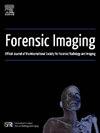揭示PMCT诊断的准确性:考虑死后变化和时间间隔的肺炎检测
IF 1
Q4 RADIOLOGY, NUCLEAR MEDICINE & MEDICAL IMAGING
引用次数: 0
摘要
尸检CT (PMCT)在评估肺实质时面临挑战,因为图像是在呼气状态下获得的,导致肺水肿重分布的严重程度不同,伴有重力依赖性衰减,从磨玻璃到完全浑浊。本回顾性研究评估重力依赖性衰减和死后时间间隔(PTI)对PMCT诊断急性肺炎准确性的影响。材料与方法采用PMCT和尸检的死亡患者为研究对象。两名放射科医生和两名病理学家的一致评估重新检查了不同肺叶的图像和组织学样本。对影像学和组织学结果进行评分,包括急性肺炎、重力依赖性衰减严重程度和肺水肿的存在。计算PTI并与重力相关衰减严重程度相关。建立交叉表来计算诊断参数。结果纳入57例,排除4例,肺叶完全混浊44例。168个肺叶留作分析。平均PTI为22 h 47 min。PTI与重力相关衰减严重程度呈弱相关(τb = 0.125, p = 0.016)。急性肺炎患病率为24.4%,PMCT对所有肺叶的敏感性和特异性分别为31.71%和85.83%。PMCT在无重力依赖性衰减或轻微重力依赖性衰减的亚组和死后16小时内扫描的患者中表现更好。结论PMCT对肺实质的解释具有挑战性。由于样本量有限,统计效力有限。PMCT更适合于排除急性肺炎,而不是检测其存在。应避免延长PTI,因为随时间增加的重力依赖性衰减严重程度限制了PMCT的灵敏度。本文章由计算机程序翻译,如有差异,请以英文原文为准。
Unveiling the diagnostic accuracy of PMCT: Detection of pneumonia considering postmortem changes and time intervals
Purpose
Postmortem CT (PMCT) faces challenges in assessing lung parenchyma due to images being acquired in expiratory state, leading to varying severity of pulmonary edema redistribution with gravity-dependent attenuation ranging from ground glass to full opacification. This retrospective study assessed the effect of gravity-dependent attenuation and the postmortem time interval (PTI) on the diagnostic accuracy of PMCT for detecting acute pneumonia.
Materials and methods
Deceased patients who underwent PMCT and autopsy were included. Consensus evaluations by two radiologists and two pathologists re-examined images and histological samples of separate lung lobes. Scores were assigned for radiological and histological findings, including the presence of acute pneumonia, gravity-dependent attenuation severity, and pulmonary edema. PTI was calculated and correlated with gravity-dependent attenuation severity. Crosstabs were created to calculate diagnostic parameters.
Results
Fifty-seven patients were included, with four excluded and 44 fully opacified lung lobes. 168 lung lobes remained for analysis. The average PTI was 22 hours and 47 min. A weak correlation was observed between PTI and gravity-dependent attenuation severity (τb = 0.125, p = 0.016). Acute pneumonia prevalence was 24,4 %, with sensitivity and specificity of PMCT for all lung lobes at 31,71 % and 85,83 %, respectively. PMCT performed better in subgroups with none or slight gravity-dependent attenuation and in patients scanned within 16 hours after death.
Conclusion
Interpretation of lung parenchyma with PMCT is challenging. Statistical power was limited due to a limited sample size. PMCT is more suited for excluding acute pneumonia than detecting its presence. Prolonging PTI should be avoided, as increasing gravity-dependent attenuation severity over time limits PMCT sensitivity.
求助全文
通过发布文献求助,成功后即可免费获取论文全文。
去求助
来源期刊

Forensic Imaging
RADIOLOGY, NUCLEAR MEDICINE & MEDICAL IMAGING-
CiteScore
2.20
自引率
27.30%
发文量
39
 求助内容:
求助内容: 应助结果提醒方式:
应助结果提醒方式:


